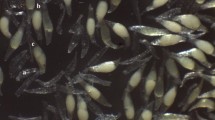Abstract
Studies on phenology and reproductive biology were carried out in 15 populations of Rauvolfia serpentina (L.) Benth. ex Kurz (2n = 22). Two different sizes of pollen grains (82.5 ± 5 and 52.3 ± 5 µm) with viability up to 85–95 % were observed. The receptivity of stigma was found to be 1 day prior to anthesis between 08.45 and 09.15 a.m. Study revealed that this species is preferentially cross pollinated and is well adopted to achieve effective pollination. Reproductive success in terms of fruit set is poor due to limitation of compatible pollens.



Similar content being viewed by others
References
Alexander, M. P. (1969). Differential staining of aborted and non aborted pollen. Stain Technology, 44, 117–122.
Bawa, K. S. (1974). Breeding systems of tree species of a lowland tropical community. Evolution, 28, 85–92.
Bernardello, G., Aguilar, R., & Anderson, G. J. (2004). The reproductive biology of Sophora fernandeziana (Leguminosae), a vulnerable endemic species from Isla Robinson Crusoe. American Journal of Botany, 91(2), 198–206.
Calvo, R. N. (1990). Inflorescence size and fruit distribution among individuals in three orchid species. American Journal of Botany, 77, 1378–1381.
Cruden, R. W., & Miller, W. S. (1981). Pollen–ovule ratio, pollen size and the ratio of stigmatic area to the pollen bearing area of the pollinator: A hypothesis. Evolution, 35, 964–974.
Faegri, K. & Pijl, L. (1979). The principles of pollination ecology (xii + pp. 244). New York: Pergamon Press.
Jain, S. P., Singh, J., & Singh, S. C. (2003). Rare and endangered medicinal and aromatic plants of Madhya Pradesh. Journal of Economic Taxonomic Botany, 27, 925–932.
Johanson, D. A. (1940). Plant microtechnique. New York, NY: McGraw-Hill.
Lopes, A. V., & Machado, I. C. (1999). Pollination and reproductive biology of Rauvolfia grandiflora (Apocynaceae): Secondary pollen presentation, herkogamy and self-incompatibility. Plant Biology, 1(5), 547–553.
Martin, F. W. (1958). Staining and observing pollen tubes in the style by means of fluorescence. Stain Technology, 34, 125–128.
Nagrajan, B., Nicodemus, A., Mandal, A. K., Verma, R. K., Gireesan, K., & Mahadevan, N. P. (1998). Phenology and controlled pollination studies in tamarind. Silvae Genetica, 47(5–6), 237–241.
Newbigim, E., Anderson, M. A., & Clarke, A. E. (1993). Gametophytic self-incompatibility systems. Plant Cell, 5, 1315–1324.
Rajendra, K., & D’souza, L. (1999). In vitro propagation of ayurvedic plants. In I. A. Khan & A. Khanum (Eds.), Role of biotechnology in medicinal and aromatic plants (pp. 207–215). Hyderabad: Ukaaz Publications.
Sihag, R. C., & Wadhwa, N. (2011). Floral and reproductive biology of Sarpagandha Rauvolfiaserpentina (Gentianales: Apocynaceae) in semi-arid environment of India. Journal of Threatened Taxa, 3(1), 1432–1436.
Sogo, A., & Tobe, H. (2006). Mode of pollen-tube growth in pistils of Myrica rubra (Myricaceae): A comparison with related families. Annals of Botany, 97(1), 71–77.
Tyler, V. E., Brady, L. Y., & Robbers, J. E. (1981). Pharmacognosy (8th ed., pp. 61–63). Philadelphia: Lea and Febiger.
Wiens, D., Calvin, C. L., Wilson, C. A., Davern, C. I., Frank, D., & Seavey, S. R. (1987). Reproductive success, spontaneous embryo abortion and genetic load in flowering plants. Oecologia, 71, 501–509.
Wyatt, R., Broyles, S. B., & Lipow, S. R. (2000). Pollen–ovule ratios in Milkweeds (Asclepiadaceae): An exception that probes the rule. Systematic Botany, 25(2), 171–180.
Acknowledgments
Financial support from the National Medicinal Plants Board, Government of India, New Delhi (Sanction No. GO/MP/-07/2006) is gratefully acknowledged.
Author information
Authors and Affiliations
Corresponding author
Rights and permissions
About this article
Cite this article
Usmani, G., Mandal, A.K., Chawhaan, P.H. et al. Reproductive biology and breeding system in Rauvolfia serpentina (L.) Benth. ex Kurz. Ind J Plant Physiol. 21, 31–36 (2016). https://doi.org/10.1007/s40502-015-0193-0
Received:
Accepted:
Published:
Issue Date:
DOI: https://doi.org/10.1007/s40502-015-0193-0




